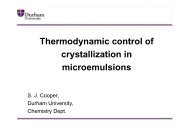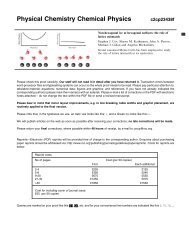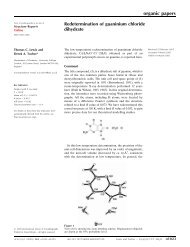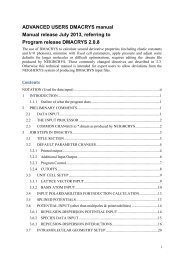An Introduction to the Theory of Crystalline Elemental Solids and ...
An Introduction to the Theory of Crystalline Elemental Solids and ...
An Introduction to the Theory of Crystalline Elemental Solids and ...
You also want an ePaper? Increase the reach of your titles
YUMPU automatically turns print PDFs into web optimized ePapers that Google loves.
2<br />
<strong>and</strong> many o<strong>the</strong>r materials which are not obviously crystalline in appearance possess<br />
a long range crystalline structure. Indeed metals <strong>and</strong> semiconduc<strong>to</strong>rs <strong>and</strong> many o<strong>the</strong>r<br />
insula<strong>to</strong>rs aside from just diamond <strong>and</strong> salt adopt crystalline structures.<br />
The key property <strong>of</strong> crystalline solids is <strong>the</strong>ir inherent symmetry which arises because <strong>of</strong><br />
<strong>the</strong> regular arrangement <strong>of</strong> <strong>the</strong>ir nuclei. It is interesting <strong>to</strong> note, however, that <strong>the</strong> actual<br />
definition <strong>of</strong> <strong>the</strong> term crystal provided by <strong>the</strong> International Union <strong>of</strong> Crystallography<br />
(IUC) is somewhat broader than a discussion based on periodicity <strong>of</strong> <strong>the</strong> a<strong>to</strong>ms would<br />
imply. Specifically, IUC define a crystal as “any solid having an essentially discrete<br />
diffraction diagram”. This definition, which is clearly somewhat ill-defined, has arisen<br />
mainly <strong>to</strong> account for <strong>the</strong> observations, from <strong>the</strong> 1980s, <strong>of</strong> quasiperiodic crystals,<br />
so-called “quasicrystals” [1]. Thus periodic crystals, which we will focus on here, are just<br />
a subset. How <strong>the</strong> nuclei are arranged leads <strong>to</strong> <strong>the</strong> crystal structure which is <strong>the</strong> unique<br />
arrangement <strong>of</strong> a<strong>to</strong>ms in a crystal composed <strong>of</strong> a unit cell: a set <strong>of</strong> a<strong>to</strong>ms arranged in a<br />
particular way which is periodically repeated in three dimensions on a lattice. The unit<br />
cell is given in terms <strong>of</strong> its lattice parameters, <strong>the</strong> length <strong>of</strong> <strong>the</strong> unit cell edges <strong>and</strong> <strong>the</strong><br />
angles between <strong>the</strong>m.<br />
Crystallographers are adept at categorizing, counting, <strong>and</strong> systematizing crystal types<br />
according <strong>to</strong> <strong>the</strong>ir symmetry <strong>and</strong> crystal system. We will not venture in<strong>to</strong> <strong>the</strong> world<br />
<strong>of</strong> crystallography except <strong>to</strong> say that for a general crystal structure in which objects<br />
<strong>of</strong> arbitrary symmetry are translated on a so-called Bravais lattice that <strong>the</strong>re turn out<br />
<strong>to</strong> be 230 different symmetry groups that a lattice can have, known as <strong>the</strong> 230 space<br />
groups. When <strong>the</strong> object <strong>to</strong> be translated (<strong>the</strong> “basis”) is completely symmetric, such<br />
as a single a<strong>to</strong>m is, <strong>the</strong>re turn out <strong>to</strong> be fourteen space groups (<strong>the</strong> fourteen Bravais<br />
lattices) falling in<strong>to</strong> seven crystal structures (cubic, tetragonal, orthorombic, monoclinic,<br />
triclinic, trigonal, <strong>and</strong> hexagonal). Fortunately, for present purposes, we do not need <strong>to</strong><br />
worry about all 230 space groups or even all fourteen Bravais lattices since elemental<br />
solids under st<strong>and</strong>ard conditions adopt a very small number <strong>of</strong> structures. Indeed more<br />
than 70% [2] <strong>of</strong> all elemental solids adopt one <strong>of</strong> <strong>the</strong> following four crystal structures:<br />
• Body-Centered Cubic (bcc): This is a simple cubic structure with a<strong>to</strong>ms at <strong>the</strong><br />
corner <strong>of</strong> a cube along with an additional a<strong>to</strong>m at <strong>the</strong> center <strong>of</strong> <strong>the</strong> cube (Fig. 1(a)).<br />
The alkali metals <strong>and</strong> many early transition metals adopt this structure;<br />
• Face-Centered Cubic (fcc): Again this is a simple cubic structure but now with an<br />
additional a<strong>to</strong>m at <strong>the</strong> center <strong>of</strong> each square face (Fig. 1(b)). Most late transition<br />
<strong>and</strong> noble metals adopt this structure as well as <strong>the</strong> inert gas solids <strong>and</strong> some <strong>of</strong> <strong>the</strong><br />
alkaline earth elements;<br />
• Hexagonal Close Packed (hcp): This consists <strong>of</strong> two interpenetrating simple hexagonal<br />
lattices as shown in Fig. 1(c). Several transition metals adopt this structure;<br />
• Diamond: This consists <strong>of</strong> two interpenetrating face-centered cubic lattices<br />
(Fig. 1(d)). The group IV elements (C, Si, Ge, <strong>and</strong> Sn) <strong>of</strong>ten crystalize in this<br />
structure.<br />
All <strong>the</strong> elements we discuss in <strong>the</strong> following will be in one <strong>of</strong> <strong>the</strong>se four crystal structures.<br />
2.2 Cohesive energies







